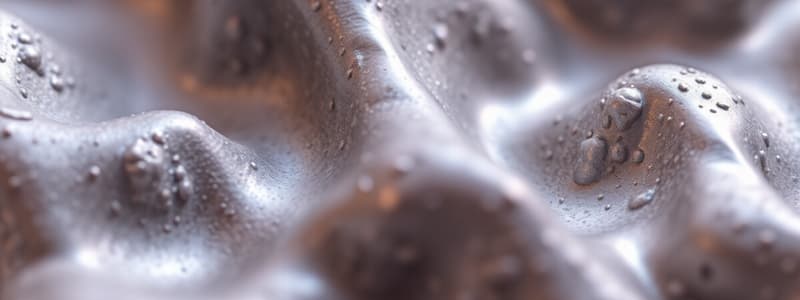Podcast
Questions and Answers
What property indicates how a material resists the flow of electric current?
What property indicates how a material resists the flow of electric current?
- Melting Point
- Thermal Conductivity
- Electrical Resistivity (correct)
- Dielectric Strength
Which property describes the temperature at which a polymer begins to deform under load?
Which property describes the temperature at which a polymer begins to deform under load?
- Melting Point
- Specific Heat
- Heat Distortion Temperature (correct)
- Coefficient of Expansion
Which of the following describes the deterioration of a metal due to environmental reactions?
Which of the following describes the deterioration of a metal due to environmental reactions?
- Caustic Brittleness
- Thermal Conductivity
- Corrosion (correct)
- Dielectric Breakdown
What is the ratio of the density of a substance compared to a standard substance called?
What is the ratio of the density of a substance compared to a standard substance called?
What property measures the quantity of heat required to raise the temperature of one gram of a substance by one degree Celsius?
What property measures the quantity of heat required to raise the temperature of one gram of a substance by one degree Celsius?
What is tensile stress?
What is tensile stress?
Which property best describes a material's ability to return to its original shape after deformation?
Which property best describes a material's ability to return to its original shape after deformation?
What does the yield strength of a material indicate?
What does the yield strength of a material indicate?
How is ultimate tensile strength calculated?
How is ultimate tensile strength calculated?
What is compressive strain?
What is compressive strain?
Which of the following best defines brittleness in materials?
Which of the following best defines brittleness in materials?
What does creep refer to in material science?
What does creep refer to in material science?
Which stress is experienced when applying a load that pulls apart two sections of material?
Which stress is experienced when applying a load that pulls apart two sections of material?
What is defined as the phenomenon where materials exert an attractive or repulsive force on other materials?
What is defined as the phenomenon where materials exert an attractive or repulsive force on other materials?
What is the ratio of uniaxial stress over uniaxial strain called?
What is the ratio of uniaxial stress over uniaxial strain called?
Which property describes a material's ability to return to its original shape after the removal of a straining force?
Which property describes a material's ability to return to its original shape after the removal of a straining force?
What is the measure of the response of electrons to a magnetic field known as?
What is the measure of the response of electrons to a magnetic field known as?
Which of the following terms describes the increase in length, area, or volume in response to an increase in temperature?
Which of the following terms describes the increase in length, area, or volume in response to an increase in temperature?
Which type of materials are known to strongly attract each other?
Which type of materials are known to strongly attract each other?
What type of stress is induced in a body due to changes in temperature?
What type of stress is induced in a body due to changes in temperature?
Which law states that stress is linearly proportional to strain?
Which law states that stress is linearly proportional to strain?
Flashcards are hidden until you start studying
Study Notes
Physical Properties
- Mass Density: The mass of a material per unit volume.
- Weight Density: The weight of a material per unit volume.
- Dielectric Strength: The maximum electric field a material can withstand without breaking down.
- Electrical Resistivity: A measure of a material's resistance to electric current.
- Melting Point: The temperature at which a material changes state from solid to liquid.
- Heat Distortion Temperature: The temperature at which a polymer plastic deforms under specific loads.
- Refractive Index: A dimensionless number that indicates how much light bends when passing through a medium.
- Specific Gravity: The ratio of the density of a substance to the density of a standard substance.
- Thermal Conductivity: A material's ability to conduct heat.
- Coefficient of Expansion: A material's tendency to change its shape, area, or volume in response to temperature changes.
- Specific Heat: The amount of heat required to raise the temperature of one gram of a substance by one Celsius degree.
Chemical Properties
- Corrosion: The deterioration of a metal due to reactions with its environment.
- Caustic Brittleness: The phenomenon where a material, typically in a boiler under stress, becomes brittle due to the accumulation of caustic substances.
Mechanical Properties
- Stress: A measure of the force acting on a unit area of an imaginary section through a body.
- Force: An influence that causes an object to undergo a change.
- Loads: External forces acting on a rigid body.
- Strain: The deformation of a solid due to stress.
- Tension: A force that pulls two sections of a material apart.
- Tensile Stress: Force acting away from the point of application.
- Tensile Strain: Measures the deformation of an object under tensile stress.
- Compression: A load that squeezes the ends of a cylindrical specimen.
- Compressive Stress: Force acting towards the point of application.
- Compressive Strain: The change in length per original length due to compressive force.
- Shearing: A load applied parallel to a plane that causes one side of the material to slide across the other.
- Bending: A load that causes a material to curve.
- Torsion: A force that causes twisting in a material.
- Elastic Limit: The maximum stress a material can withstand without experiencing permanent deformation when the load is released.
- Yield Strength: The stress required to produce a specific amount of plastic deformation.
- Proportional Limit: The highest stress at which stress is linearly proportional to strain.
- Ultimate Tensile Strength: An engineering value calculated by dividing the maximum load a material experiences during a tensile test by the initial cross-section of the test sample.
- True Fracture Strength: The load at fracture divided by the cross-sectional area of the sample.
- Ductility: A material's ability to be stretched into wires permanently without fracture.
- Malleability: A metal's ability to be hammered, rolled, or pressed into shapes without fracturing.
- Brittleness: A material's tendency to fracture with little or no plastic deformation.
- Stiffness: A material's tendency to return to its original shape after being subjected to a force.
- Strength: A measure of how much stress a material can withstand before it deforms permanently.
- Hardness: A material's resistance to surface indentation.
- Creep: Slow and continuous deformation of a material under constant stress, usually at high temperatures.
- Fracture: The breakage of a material into separate parts under stress.
- Fatigue: Changes in a material's mechanical properties under repeated stress.
- Elasticity: A material's property to return to its original shape when the straining force is removed.
- Plasticity: A material's ability to deform permanently.
- Hooke's Law: States that stress is linearly proportional to strain within the elastic limit.
- Modulus of Elasticity: A material's resistance to elastic deformation.
- Young's Modulus: The ratio of uniaxial stress to uniaxial strain.
- Shear Modulus: The ratio of shear stress to shear strain.
- Bulk Modulus: The ratio of normal stress to volumetric strain.
Other Properties and Characteristics of Materials
- Thermal Properties: How a material responds to the application of heat.
- Heat Capacity: The amount of energy needed to raise the temperature of a material by a unit degree.
- Thermal Expansion: The increase in length, area, or volume of a material in response to an increase in temperature.
- Thermal Conduction: The transfer of thermal energy from high to low temperature regions within a material.
- In solids, heat is transported by vibrational lattice waves or phonons.
- Ceramics and polymers are poor thermal conductors because they have low free electron concentrations, and phonon conduction dominates.
- Thermal Stresses: Stresses induced in a body due to temperature changes.
- Thermal Shock Resistance: A material's ability to withstand plastic deformation under thermal stress.
- Bimetal Strip: Two metals bonded together with different coefficients of expansion.
Magnetism
- Magnetism: The phenomenon where materials exert attractive or repulsive forces on other materials.
- Magnetic Susceptibility: Measures the response of electrons to a magnetic field.
- Magnetic Dipoles: Generated by moving electrically charged particles; imaginary lines of force indicating the direction of the force.
- Magnetic Field Vectors: Externally applied magnetic fields.
- Magnetic Induction: The magnitude of the internal field strength within a substance subjected to a magnetic field.
- Permeability: A property of a specific medium through which a magnetic field passes and in which magnetic induction is measured.
- Magnetization of a Material: Dependent on susceptibility and magnetic field strength.
- Ferromagnetic: Certain materials that strongly attract each other.
- Antiferromagnetic: Magnetic moments of each atom are arranged in such a way that every second moment is in the opposite direction to the first.
Studying That Suits You
Use AI to generate personalized quizzes and flashcards to suit your learning preferences.




